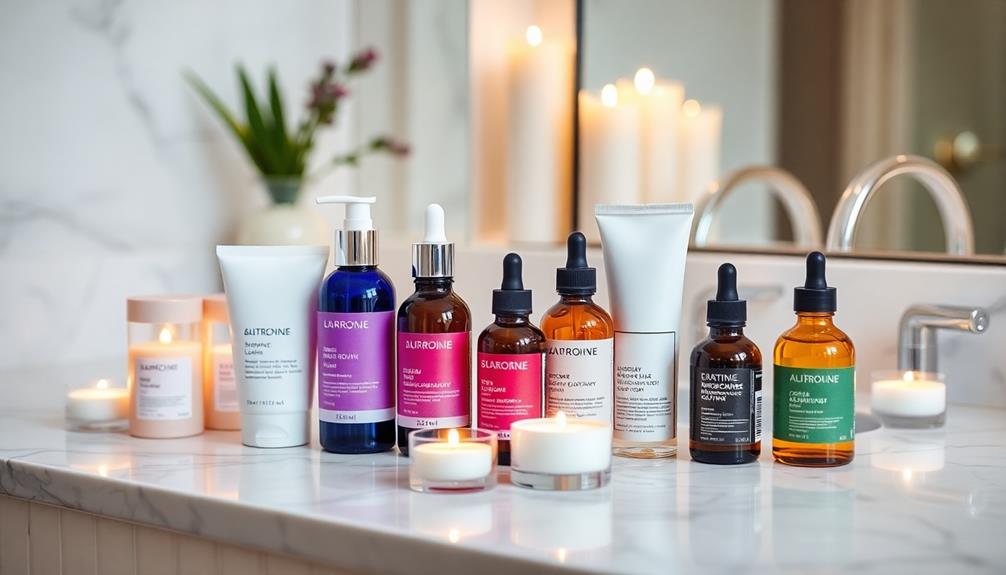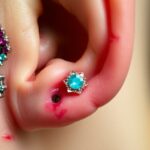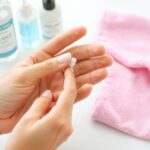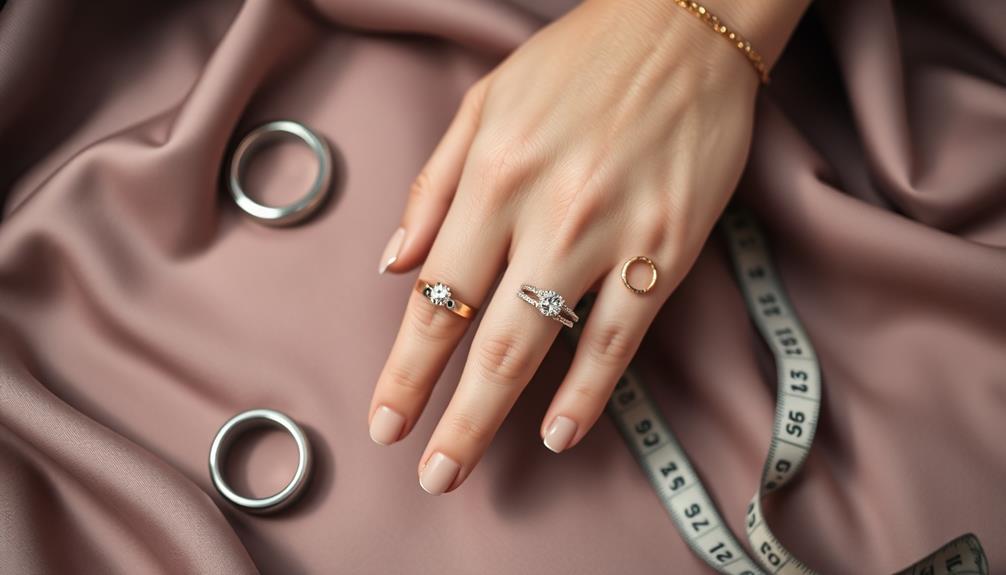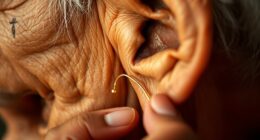Piercings can invite infections like localized cellulitis, especially with cartilage and genital piercings. To prevent these issues, always choose a licensed piercer and guarantee they follow strict hygiene practices. Opt for hypoallergenic jewelry, such as surgical stainless steel or titanium, and clean your piercings twice daily with saline solution. Watch for redness, swelling, or pus, as these may signal infection. Early intervention is vital, so don't hesitate to seek medical advice if symptoms persist. By understanding these risks and preventive measures, you'll be better equipped to maintain your piercing's health and safety, and there's plenty more to discover!
Key Takeaways
- Proper aftercare, including regular saline cleaning, is crucial for preventing infections in piercings.
- Choosing licensed body art studios ensures sterile equipment and sanitation practices to minimize infection risks.
- Selecting hypoallergenic jewelry made from materials like surgical stainless steel, titanium, or gold reduces allergic reactions and complications.
- Common signs of infection include persistent redness, swelling, pus-like discharge, and tenderness; seek medical advice if these occur.
- Regularly monitoring healing and following tailored aftercare instructions specific to the piercing type can prevent complications.
Overview of Piercing Infections

When getting a body piercing, it's vital to be aware of the potential for infections. Localized cellulitis is the most common complication you might encounter, and if left untreated, it can lead to severe systemic issues.
Infections occur more frequently in cartilage piercings than in earlobe piercings, with about 35% of individuals facing complications. The main culprits behind these piercing infections are bacteria like Staphylococcus aureus and Pseudomonas aeruginosa, with the latter often found in cartilage areas.
If you're considering genital piercings, keep in mind that they come with an increased risk of sexually transmitted infections (STIs) such as Neisseria gonorrhea and Chlamydia trachomatis.
To minimize your risk of piercing infections, proper aftercare is essential. This includes cleaning the area regularly with saline and avoiding water exposure during the healing process.
By following these guidelines, you can greatly reduce your chances of developing an infection, ensuring your body piercing experience remains as safe and enjoyable as possible.
Common Types of Infections

Piercing infections can manifest in various forms, each presenting its own set of challenges. One of the most common types is localized cellulitis, often caused by Staphylococcus and Streptococcus bacteria. You'll find that infection rates are higher for piercings through cartilage, like high ear piercings, which can escalate to severe complications if not addressed promptly.
Genital piercings pose unique risks, increasing the likelihood of sexually transmitted infections due to their proximity to mucosal surfaces. Although lip and tongue piercings have relatively low infection rates, complications like bleeding or airway obstruction can still occur.
To highlight these concerns, here's a quick overview:
| Infection Type | Risk Factors | Prevention Tips |
|---|---|---|
| Localized cellulitis | Poor hygiene, non-sterile techniques | Guarantee proper hygiene |
| Cartilage infections | High infection rates | Use reputable body art studios |
| STIs from genital piercings | Proximity to mucosal surfaces | Get piercings in sterile environments |
| Oral infections | Oral bacteria presence | Keep piercings clean |
Being informed and choosing licensed body art studios can considerably reduce your risk of infections.
Symptoms of Infected Piercings

When you notice symptoms like redness, swelling, or a pus-like discharge around your piercing, it could signal an infection.
It's essential to distinguish these signs from normal healing, as some symptoms can overlap.
If you experience fever or unusual discharge, it's time to seek medical help to prevent complications.
Common Symptoms Overview
In the days following a new piercing, you might notice some common symptoms that could signal an infection.
It's essential to monitor these signs closely, as they can help you determine whether your piercing is healing properly or if you need to take action.
Here are three key symptoms to watch for:
1. Redness and Swelling: If the area around your piercing becomes noticeably red or swollen, it could indicate an infection.
Normal healing may involve some swelling, but excessive inflammation is a concern.
2. Tenderness: Feeling tenderness or pain around the piercing site is another common symptom of infected piercings.
While some discomfort is expected, intense pain can suggest a problem.
3. Pus-like Discharge: If you notice a pus-like discharge coming from the piercing, this is a strong sign of infection.
Additionally, you may feel warmth and itchiness in the area, which further indicates that something might be wrong.
Keep a close eye on these symptoms, and don't hesitate to seek professional help if they worsen or don't improve.
Early intervention can prevent complications.
Distinguishing Infection Signs
Recognizing the signs of an infected piercing is essential for prompt treatment and recovery. When you notice symptoms like redness, swelling, tenderness, or pus-like discharge at your piercing sites, it could indicate a localized infection. Pay close attention to how your piercing feels, especially if swelling and tenderness persist beyond a few days, as this may not just be normal healing.
Here's a quick reference table to help you identify the symptoms:
| Symptom | Indication | Action |
|---|---|---|
| Redness | Possible infection | Monitor closely |
| Swelling | Localized infection | Consider treatment |
| Tenderness | Infection or irritation | Consult a professional |
| Pus-like discharge | Confirmed infection | Seek medical advice |
Additionally, if you experience increased warmth around the piercing or develop a fever, these symptoms might suggest a more serious infection requiring urgent attention. Remember, individuals with underlying health conditions, like diabetes, should stay vigilant as they may experience more severe symptoms. Prioritize prevention by maintaining good hygiene and monitoring your piercings closely.
When to Seek Help
Identifying the signs of an infected piercing is important, but knowing when to seek professional help can make a significant difference in your recovery.
If you notice any of the following symptoms, don't hesitate to reach out for treatment:
- Redness and Swelling: If your ear piercing shows increasing redness, swelling, or tenderness, it may indicate a local infection.
- Pus-like Discharge: Pus or any unusual discharge from the piercing site is a clear sign that you should seek help to prevent infection from worsening.
- Systemic Symptoms: If you experience fever, chills, or malaise along with localized symptoms, it's vital to consult a healthcare provider to rule out serious complications.
Risk Factors for Infections

When considering piercings, hygiene practices are essential for preventing infections.
You should always choose a licensed body art studio that uses sterile equipment and follows strict sanitation protocols.
Additionally, be mindful of the jewelry materials you select, as certain metals can cause allergic reactions and increase your risk of infection.
Hygiene Practices
How can you guarantee your piercings stay infection-free? By sticking to proper hygiene practices throughout the healing process, you can greatly minimize your risk of infections. Here are three essential tips to follow:
- Wash Your Hands: Always wash your hands before touching your piercings. Dirty hands are a common source of bacteria that can lead to infections.
- Use Sterile Equipment: Confirm that your piercer uses sterile needles and properly sterilized equipment. This step is vital in preventing the introduction of pathogens during the piercing process.
- Regularly Clean Your Piercings: Clean your piercings twice daily with saline solutions or mild soap. This practice not only helps prevent infection but also promotes healing during the initial recovery period.
Additionally, opting for hypoallergenic jewelry made from materials like surgical stainless steel or titanium can lower the risk of allergic reactions, which may compromise your skin and lead to infections.
Jewelry Materials
Choosing the right jewelry materials plays a notable role in preventing infections associated with piercings. When selecting body jewelry, opt for hypoallergenic options like surgical stainless steel, titanium, or gold. These materials are less likely to trigger an allergic reaction, which can lead to complications and infections from body piercing.
Additionally, it's important to take into account the healing time for different piercings, as some may require specific jewelry materials for ideal recovery healing time varies.
Be cautious of jewelry made from nickel, a common allergen that can cause irritation and increase infection risk for sensitive individuals. It's vital to source your jewelry from reputable suppliers to verify that it's sterile and free from contaminants.
Poorly finished jewelry with rough edges can create micro-abrasions, giving bacteria entry points and heightening the risk of infection.
Always choose jewelry designed specifically for body piercings instead of fashion jewelry, as the latter may not meet safety standards and could introduce foreign bodies into your skin.
By prioritizing quality jewelry materials, you can greatly reduce the chance of developing infections and verify a safer, more enjoyable piercing experience.
Prevention Strategies
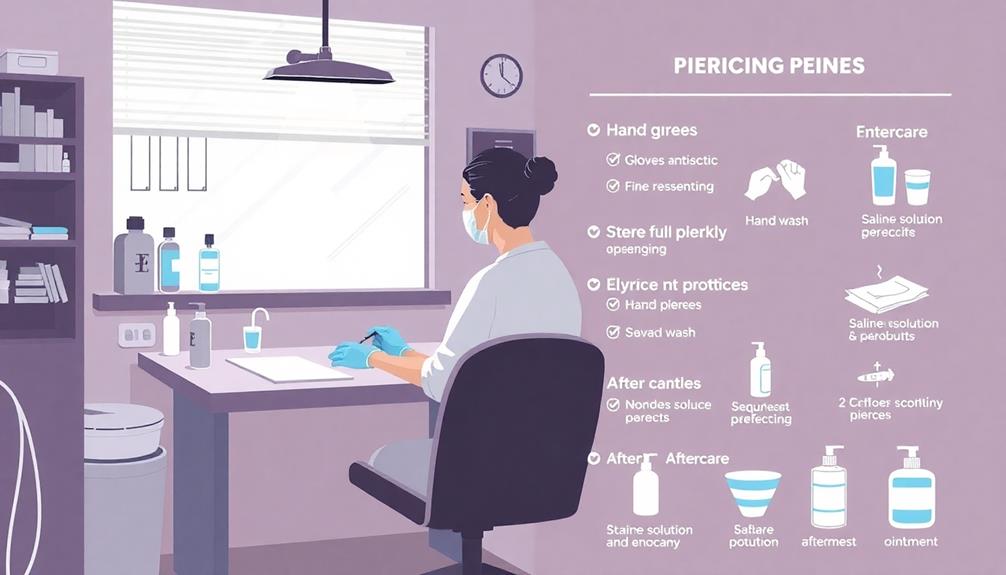
Ensuring a safe and infection-free piercing experience starts with selecting a qualified piercer who adheres to strict hygiene protocols. A professional piercer uses disposable gloves and sterile equipment, minimizing the risk of skin infections.
Additionally, it's important to conduct research on the aftercare requirements specific to your piercing type, as proper care can greatly reduce the likelihood of complications. For example, understanding the ultimate hamster care guide can provide insights into maintaining cleanliness and preventing infections.
To enhance your prevention strategies, consider these steps:
- Choose Hypoallergenic Jewelry: Opt for jewelry made from surgical stainless steel, titanium, or gold. This reduces the risk of allergic reactions that could lead to infections.
- Maintain Proper Hygiene: Clean the piercing site twice daily with saline solution or mild soap. Avoid harsh cleaners that can irritate your skin and promote bacterial growth.
- Follow Aftercare Instructions: Educate yourself about the specific aftercare instructions related to your piercing type. Each site has unique healing processes, and understanding these can help prevent complications.
Treatment Options

Infections can complicate the piercing experience, but effective treatment options are available to help you recover. For mild infections, start with warm compresses and apply antibiotic ointment like bacitracin or mupirocin to reduce localized symptoms.
Keeping your jewelry in place is vital, as removing it can exacerbate the problem. It's also important to take into account financial planning during recovery, especially if medical expenses arise.
If the infection worsens, your healthcare provider might prescribe oral antibiotics such as cephalexin or clindamycin to target common pathogens like Staphylococcus and Streptococcus.
In cases of abscess formation, incision and drainage may be necessary. This procedure helps remove infected material and typically involves a treatment duration of about five days, extending if no improvement occurs.
For high ear piercings, particularly infected ones, fluoroquinolones like ciprofloxacin might be recommended, and it's vital to remove jewelry for effective healing.
Regular follow-ups with your healthcare provider are essential to monitor the infection's progress and guarantee proper healing of the piercing.
When to Seek Help

It's crucial to recognize when to seek help for a piercing issue. Ignoring certain symptoms can lead to complications that could have been easily managed early on. Here are three key indicators that it's time to consult a healthcare provider:
- Persistent redness and swelling: If you notice these symptoms continuing beyond the initial healing period, it may indicate an infection that requires professional treatment.
- Systemic symptoms: Experiencing fever or other systemic symptoms alongside localized signs suggests a more serious infection. Don't hesitate to contact your healthcare provider immediately.
- Keloid formation: Any unusual scarring or keloid formation around your piercing should prompt a consultation for evaluation and potential treatment options.
Additionally, if you're treating an infection at home with warm compresses and topical antibiotics but see no improvement after five days, you should seek medical attention.
A healthcare provider may prescribe oral antibiotics or other interventions to help you recover. Remember, staying proactive about your piercing health can prevent serious complications down the line.
Frequently Asked Questions
How Can I Prevent My Piercing From Getting Infected?
To prevent your piercing from getting infected, choose a certified professional, clean it twice daily with saline, keep your hands clean, avoid water exposure, and use hypoallergenic jewelry. These steps help guarantee proper healing.
What Are the Most Common Piercing Infections?
About 35% of individuals with body piercings experience complications. The most common infections include localized cellulitis, Pseudomonas infections, and heightened risks for STIs in genital piercings, highlighting the need for proper hygiene and care.
How Do You Clean Piercings to Prevent Infection?
To clean your piercings and prevent infection, wash them twice daily with saline solution or mild soap. Always use clean hands, avoid submerging in water, and apply rubbing alcohol or antibiotic ointment as needed.
How Do You Treat an Infected Piercing?
Isn't it frustrating when a piercing gets infected? To treat it, apply warm compresses, use topical antibiotics, and consult a healthcare provider if symptoms worsen. You'll want to guarantee proper healing and avoid complications.
Conclusion
Infections from piercings can be like weeds in a garden; if you don't catch them early, they can take over. By staying vigilant and following proper aftercare, you can keep your body art flourishing. Remember, just as a gardener tends to their plants, you need to nurture your piercings with cleanliness and care. If something feels off, don't hesitate to seek help—your health is the most beautiful accessory you can wear.
Hi, my name is Danielle, and I’m an author for piercings-body.com. I have a passion for writing and love to share my knowledge on all things body piercing-related. I’m also a huge advocate for safe body modification practices and believe everyone should be able to make informed decisions about their bodies. When I’m not writing or blogging, I enjoy spending time with my family and friends, practicing yoga, and exploring new places.


